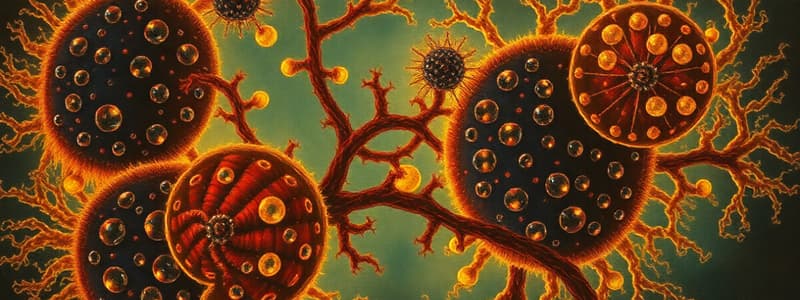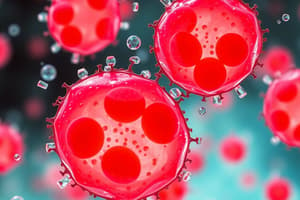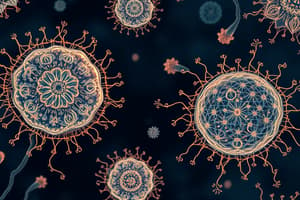Podcast
Questions and Answers
What is a characteristic feature of prokaryotic cells compared to eukaryotic cells?
What is a characteristic feature of prokaryotic cells compared to eukaryotic cells?
- Structural complexity
- Presence of membrane-bound organelles
- Larger cell size
- Lack of a true nucleus (correct)
Which cell component is responsible for providing shape and protection in plant cells?
Which cell component is responsible for providing shape and protection in plant cells?
- Cell Membrane
- Cell Wall (correct)
- Nucleus
- Cytoplasm
Which feature do animal cells lack that distinguishes them from plant cells?
Which feature do animal cells lack that distinguishes them from plant cells?
- Nucleus
- Cell Wall (correct)
- Vacuoles
- Mitochondria
What is the primary function of chloroplasts found in plant cells?
What is the primary function of chloroplasts found in plant cells?
What type of microscope would be most suitable for observing specimens that emit fluorescence?
What type of microscope would be most suitable for observing specimens that emit fluorescence?
Which part of the cell is primarily responsible for controlling the movement of substances in and out?
Which part of the cell is primarily responsible for controlling the movement of substances in and out?
In which type of cell would you most likely find a large central vacuole?
In which type of cell would you most likely find a large central vacuole?
Which type of microscope allows for viewing objects smaller than what light can display?
Which type of microscope allows for viewing objects smaller than what light can display?
What is the main role of mitochondria in a cell?
What is the main role of mitochondria in a cell?
What distinguishes eukaryotic cells from prokaryotic cells?
What distinguishes eukaryotic cells from prokaryotic cells?
Which cellular component is often described as having a 'jelly-like' consistency and found within the cell?
Which cellular component is often described as having a 'jelly-like' consistency and found within the cell?
Which of the following best defines a tissue?
Which of the following best defines a tissue?
What role does connective tissue play within an organ?
What role does connective tissue play within an organ?
How do organ systems differ from organs?
How do organ systems differ from organs?
Which statement accurately describes the relationship between cells, tissues, organs, and organisms?
Which statement accurately describes the relationship between cells, tissues, organs, and organisms?
Which organ would NOT typically be classified under the circulatory system?
Which organ would NOT typically be classified under the circulatory system?
What is the primary function of the nervous tissue?
What is the primary function of the nervous tissue?
Which of the following organisms would be classified as prokaryotic?
Which of the following organisms would be classified as prokaryotic?
In multicellular organisms, cells are specialized to perform which of the following?
In multicellular organisms, cells are specialized to perform which of the following?
Which system would be responsible for detoxifying chemicals in the body?
Which system would be responsible for detoxifying chemicals in the body?
What is the function of the illuminator in a microscope?
What is the function of the illuminator in a microscope?
Which part of the microscope is responsible for holding the slide securely in place?
Which part of the microscope is responsible for holding the slide securely in place?
To achieve a clearer image when switching to a higher magnification, which knob should be used?
To achieve a clearer image when switching to a higher magnification, which knob should be used?
Which component helps to direct and focus light through the slide for enhanced clarity?
Which component helps to direct and focus light through the slide for enhanced clarity?
What should be the first step when setting up a microscope for use?
What should be the first step when setting up a microscope for use?
What is the main purpose of the coarse focus knob?
What is the main purpose of the coarse focus knob?
Which part of the microscope connects the optics and provides a grip for transporting?
Which part of the microscope connects the optics and provides a grip for transporting?
What should you do after placing the slide on the stage of a microscope?
What should you do after placing the slide on the stage of a microscope?
Which objective lens power is typically used first during microscopy?
Which objective lens power is typically used first during microscopy?
How does the diaphragm function in relation to light during microscopy?
How does the diaphragm function in relation to light during microscopy?
Flashcards are hidden until you start studying
Study Notes
Key Terms
- Cells: Fundamental units of life, making up all living organisms.
- Eukaryotes: Cells with a nucleus and organelles; examples include humans, animals, and plants.
- Prokaryotes: Simpler cells without a nucleus; bacteria are prime examples.
- DNA (Deoxyribonucleic Acid): Molecular instructions within cells governing growth and reproduction.
- Amoeba: A single-celled organism capable of movement and feeding by shape alteration.
Cell Organization
- Tissues: Groups of similar cells collaborating for specific functions (e.g., muscle and nervous tissues).
- Organs: Composed of various tissues, multitasking to perform specific operations (e.g., the heart pumps blood).
- Organ Systems: Combinations of organs working together for complex body functions (e.g., circulatory, digestive systems).
- Organisms: Living entities consisting of multiple organ systems (e.g., humans combine several systems for survival).
Cell Types Comparison
- Prokaryotic Cells: Smaller size, no true nucleus, lack membrane-bound organelles.
- Eukaryotic Cells: Larger size, possess a defined nucleus containing DNA, have membrane-bound organelles.
- Plant Cells: Include cell walls, chloroplasts (for photosynthesis), and large vacuoles.
- Animal Cells: Lack cell walls, chloroplasts, and have small vacuoles.
Cell Components and Functions
- Cell Wall: Rigid outer layer in plant cells providing structure and protection.
- Cell Membrane: Semi-permeable barrier managing nutrient and waste exchange.
- Cytoplasm: Gel-like substance within the cell where organelles float and cellular activities occur.
- Nucleus: Control center housing DNA, regulating cell functions.
- Mitochondria: Energy producers for the cell, facilitating cellular respiration.
- Chloroplasts: Organelles in plant cells that perform photosynthesis.
- Vacuoles: Storage compartments, larger in plants than in animals.
Microscopy Techniques
- Fluorescence Microscope: Utilizes special light to visualize glowing cellular components.
- Light Microscope: Employs regular light for magnified observations of cells.
- Electron Microscope: Uses electron beams for viewing extremely small structures beyond light microscope capabilities.
Microscope Components
- Eyepiece: Lens for viewing specimens.
- Objective Lenses: Magnifying lenses for different zoom levels.
- Nosepiece: Rotatable section holding objective lenses.
- Stage: Surface for slide placement.
- Stage Clips: Secure the slide in place.
- Illuminator: Light source illuminating the specimen from below.
- Condenser: Focuses light onto the slide for clarity.
- Diaphragm: Controls light intensity reaching the slide.
- Arm: Handle for microscope transportation.
- Base: Stabilizes the microscope.
- Coarse Focus Knob: Quickly adjusts stage height for initial focus.
- Fine Focus Knob: Enables precise focusing adjustments.
Using the Microscope
- Setup: Position on a stable, well-lit surface.
- Holding: Support by arm with one hand and base with the other.
- Slide Placement: Center slide under the desired objective lens using clips.
- Focusing: Start with the lowest magnification, utilizing coarse focus; switch to higher magnifications with fine focus for detail.
Studying That Suits You
Use AI to generate personalized quizzes and flashcards to suit your learning preferences.




